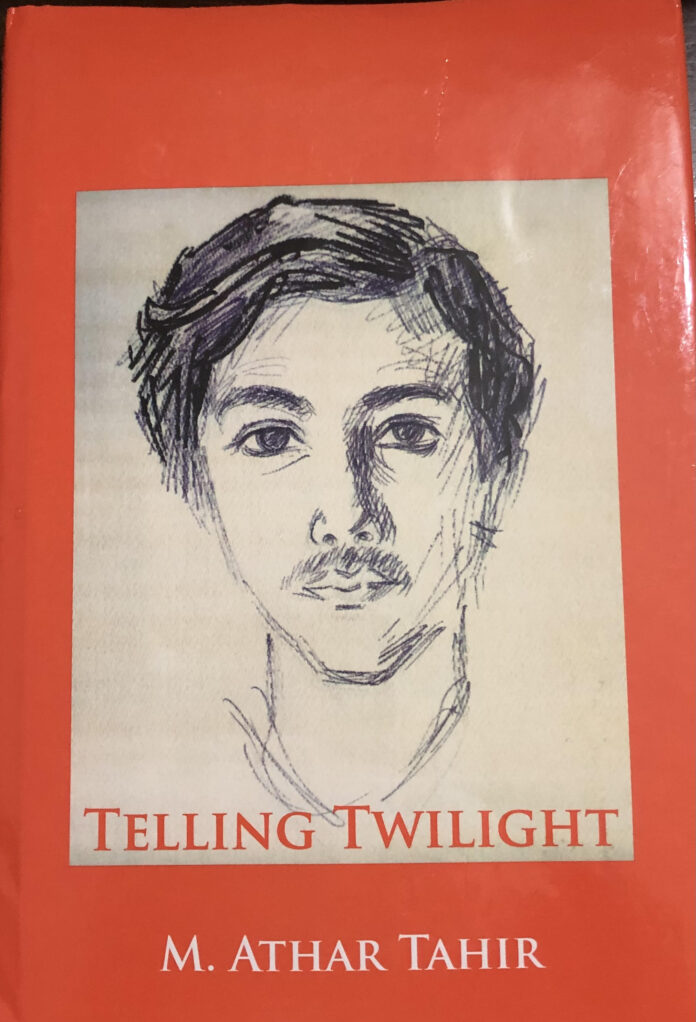Telling Twilight
Syed Afsar Sajid
Title: Telling Twilight – Author: M. Athar Tahir
Publisher: University of the Punjab, Lahore
Pages: 180 – Price: Rs.1300/-
M. Athar Tahir is an iconic literary figure with English poetry as a hallmark of his
creativity. A former Rhodes scholar and an erstwhile bureaucrat, he has to his credit
some thirty-four publications relating to Art, Fiction, Prose, Poetry, Natural History,
Juvenile Literature, Translation, Essays on Pakistani Anglophone Literature (Edited), and
Pakistani English Poetry (Edited).
He is also a recipient of a bagful of national and international awards in recognition of his unique creative, critical, and artistic genius as manifested in an enviably vast body of his work. The instant book is a fairly large collection of Athar Tahir’s sonnets, seven score (140) in number.
The author has posted encomiastic opinions/remarks of some noted academics, critics, and reviewers (both late and live) on its flaps that relate to this publication as well as another titled The Last Tea, also by the same author, besides some general observations on his literary output.
In addition, Dr. Faisal Nazir, an Assistant Professor at the department of English, University of Karachi, has penned an enlightening scholarly introduction to the book that encapsulates an erudite analysis of its content in the framework of the sonnet as a viable art form.
In his considered view, “Tahir employs the sonnet to represent a variety of religious and
secular experiences, thoughts and feelings. His poetic skill, of a high order, moulds the
form according to the needs of a specific experience. As such within the structure of the
sonnet he not only creates new rhyme schemes but he divides the mandatory fourteen
lines to create new stanza structures. Tahir uses the traditional structure of the sonnet
but his poetic needs compel him to exercise creativity.”
Sonnet is a familiar genre of poetry consisting of fourteen lines, usually in English
iambic pentameter and a complex rhyme scheme. It traces its history to Italy where it
developed in the early thirteenth century and was used by poets like Dante (1265-1321)
and Petrarch (1304-74) who composed sequence of sonnets addressed to their ladyloves
and thus founded conventions of love poetry of the Renaissance.
Thomas Wyatt (1503-42) employed this form in England and Henry Howard, Earl of Surrey (1517-47) developed it. Later Spenser, Sidney, Shakespeare, and Milton liberally employed sonnet in their poetic compositions whereafter it was revived by the Romantics and has been in much use since. In the process its scope and content, particularly in England was widened and enriched.
In the Italian form it contains two stanzas of eight and six lines each. The English form however, has three quatrains followed by a couplet at the end which is the standard form generally adopted by Athar Tahir in his scheme of verse, with certain minor alterations like 2,2,2,2,2,2,2 4,4,2,4 and 4,4,3,3, in some pieces.
Most of the sonnets in the instant book read like monologues — speculative and self-
searching — focused on themes such as ‘to be or not to be’, love and disdain, right and
wrong, belief and doubt, obvious and the symbolic, rise and fall, youth and ageing, zest
and inertia, existence and transcendence, and last but not the least, delight and distress.
The style of the poet is eruditely excursive, but without being obtrusive. It is a true
impression of his inner self, ‘clearness’ in soul and ‘goodliness’ of character being its quintessence. Some lines randomly picked from these sonnets are being reproduced
here to give the reader a fairer idea of Athar Tahir’s poetics: Not as evocative as poets’ who/Craft verbs to say and suggest beyond the/Obvious, mine are simple words like the/Monsoon drops or the owl’s to-wit-to-woo.
(Lantern Sonnet) Your prism worked. You spectrumed me into/ Colours I do not understand. When does “Like” facet into “love”? Does it ever/ Roll the rainbow to the felt white light? Sonnet XXV I will come in rhyme but with no reason/ I will come in life’s every season. (Rumi) So I need beg, in keeping with your guile/ Not a sound or some speech but a slow smile.
Sonnet LXXV
Back the building is alive with pre-teen/ Shouts as boys chase each other, awaiting/
Parents. ‘Mari sini’, flushed by the scene/ I say, ‘Come here,’ in a flash of wanting.
(Two Malay Words) Of all the nearings, few or many/ Nearing You One God, makes one, many. (Nearings)
You lived through turmoil with enduring grit,/ Your itinerant life yielding profound/
Sorrow, and I witnessed my country split/ Into two for reasons that still confound. (Du
Fu: 712-770 CE) So what is penned, is all that is re-lived./ A life not written is a life not lived.
Sonnet CXXXVIII
This scribe is disposed here pertinently to recall what he had earlier commented on
Athar Tahir’s person and art in the context of his ace verse collection The Last Tea: “To
pre-empt emotions from degenerating into a kind of sugary sentimentalism is the poet’s
prime concern. This defiance of the accepted standards has led the poet in Athar Tahir to
chart a symbolistic nay imagist path for himself in the vast arena of poesy.
The symbolist’s purpose is to induce states of mind in the reader. The imagist on the other
hand, aims at clarity of expression through the use of hard and accurate but definite
images.” The sonnets in view tend to amplify these traits of Athar’s verse.
Tahir could also be likened, though somewhat remotely, to the famed Welsh poet Dylan
Thomas (1914-53) who seemed to see life as a continuous process, saw the workings of
biology as a magical transformation producing unity out of diversity, the generations
linked with one another and man linked with nature.
Like Thomas, Tahir too uses ‘pattern and metaphor in a complex craftsmanship in order to create a ritual of celebration’. One cannot but agree with Dr. Faisal Nazir when he concludes his thoughtful ‘introduction’ by affirming that this collection of sonnets by Tahir “pulsates with the freshness of lush green landscapes, the depth of the seas, the loneliness of the deserts, the height of the skies, and the delicacy of flowers.
These sonnets mesmerize one into a state of poetic intoxication.” The publication of this collection has in effect enriched the extant body of native and (Pakistani) diasporic poetry in English. Cryptically it tells, explains and vivifies the angst of a sensitive soul re-discovering itself through the ‘ambiguities’ of a workaday existence interspersed with the spasmodic ‘tremors’ of love.





















